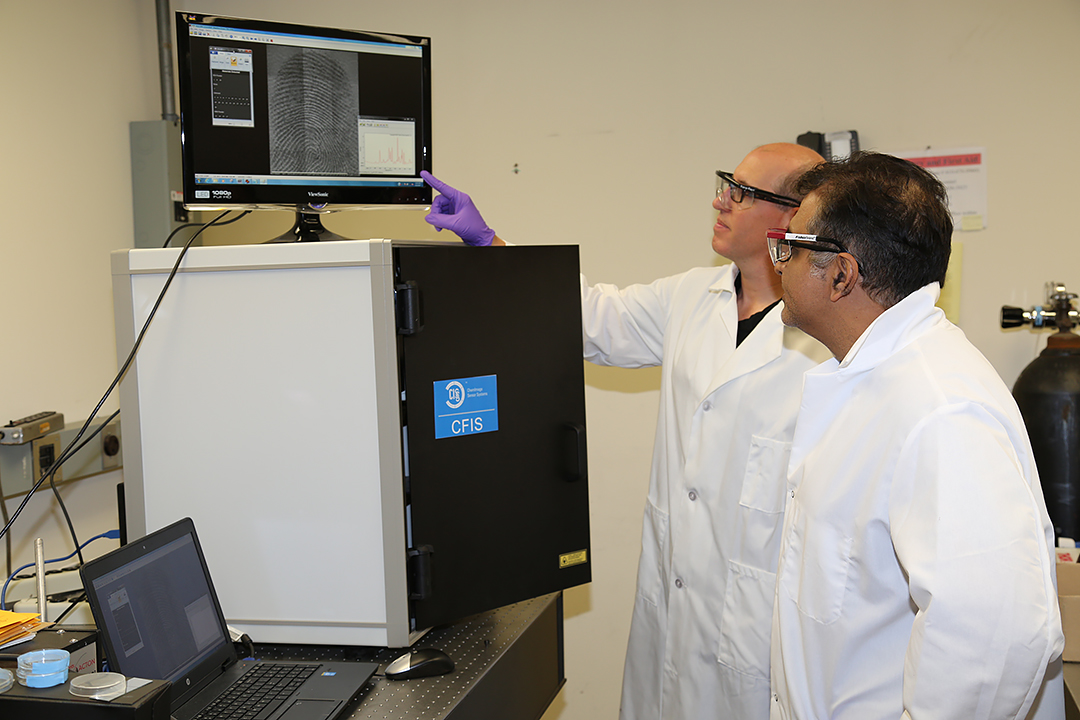// NEWS RELEASE
ECBC’s Chemical Fingerprint Imaging System Gives Warfighters and Law Enforcement a Powerful New Detection Tool
CCDC Chemical Biological Center Public Affairs | November 27th, 2017
ECBC’s Chemical Fingerprint Imaging System Gives Warfighters and Law Enforcement a Powerful New Detection Tool
DEVCOM CBC Public AffairsNovember 27th, 2017

ECBC scientists Jason Guicheteau, Ph.D. and Ashish Tripathi, Ph.D., operating the latest generation of the Chemical Fingerprint Imaging System they developed for the U.S. Army Criminal Investigation Laboratory to both identify fingerprints and analyze trace explosives residues in the grooves of the fingerprints.
When a warfighter on the battlefield is able to obtain a fingerprint of a person he suspects of planting improvised explosive devices (IEDs), often he finds out it is not enough evidence to detain him He also needs an analysis of micro-particles of explosive material embedded between the grooves of the fingerprint. Until now, he has had to choose one or the other.
That was the problem Augustus Fountain, Ph.D., the Army’s Senior Research Scientist (ST) for Chemistry, faced when he deployed to Iraq in 2010 as the chief scientist, advising the Combined Explosives Exploitation Cells, or CEXC lab. These are elite mobile field laboratories with the mission of rapidly exploiting evidence that will enable U.S. and coalition forces to capture and prosecute insurgents suspected of building or planting IEDs.
When he returned to the Edgewood Chemical Biological Center (ECBC) he assembled a research team to solve the problem, and they embarked on a six-year effort. The result is the Chemical Fingerprint Imaging System, and in July, the team delivered the first prototype to the U.S. Army Criminal Investigation Laboratory. The size of a small refrigerator, the system captures the fingerprint image and sends it electronically to the FBI’s Integrated Automated Fingerprint Identification System for identification. At the same time, the system can perform forensic analysis of the trace explosives residues found between the fingerprint grooves.
The system is fully automated so that a person with minimal training can simply insert a finger print, use a computer to mark its boundary, then walk away. The analysis of both the fingerprints and up to 100 micro-particles can be done in 30 minutes. “The Generation I Chemical Fingerprint Imaging System is much smaller, much faster, and much easier to operate than the system we first built in our research effort,” said Jason Guicheteau, Ph.D., a research chemist leading the team. “The people at the lab were excited to get started using it to revisit cold cases in their lab and make it available to our forces in Afghanistan.”
The system has many other applications. It can be used to identify narcotics as well as explosive compounds, making it ideal for use at airports and by law enforcement agencies. The system’s long-term value to the U.S. armed services is to enable war planners to get what is known as “left of boom.” The idea is to use the system as a tool in performing the steady police work it takes to whittle down the numbers of insurgents planting IEDs. Evidence produced by the technique known as Raman spectroscopy that the system uses has already been approved as evidence in U.S. courts. “Raman spectroscopy is a method ECBC uses that shines a laser on a substance. The laser light interacts with molecular vibrations of the object, causing the laser light frequency to shift slightly,” explained Ashish Tripathi, Ph.D., a chemical engineer on the team. “That slight shift reveals the type of molecular bonds in the object, which in turn leads to the identity of those molecules.”
Guicheteau and his team have big plans for the future. “In fiscal year 2018 we will reach out to commercial vendors to build a Generation II system,” said Guicheteau. “This system will be still smaller and more portable, have more sensitivity, be able to identify a greater range of explosives and narcotics, and work on curved surfaces such as a water bottle or can.”
The team plans to deliver the Generation II system to the Criminal Investigation Laboratory in 2020, and expects that the other armed services and a wide range of law enforcement agencies will covet it as a powerful new tool for building cases and getting convictions.
The U.S. Army Combat Capabilities Development Command (DEVCOM) leads in the discovery, development and delivery of technology-based capabilities to enable Soldiers to win our nation’s wars and come home safely. DEVCOM is a major subordinate command of the U.S. Army Futures Command. The DEVCOM Chemical Biological Center is the Army’s principal research and development center for chemical and biological defense technology, engineering and field operations. The DEVCOM Chemical Biological Center is headquartered at Aberdeen Proving Ground, Maryland.
